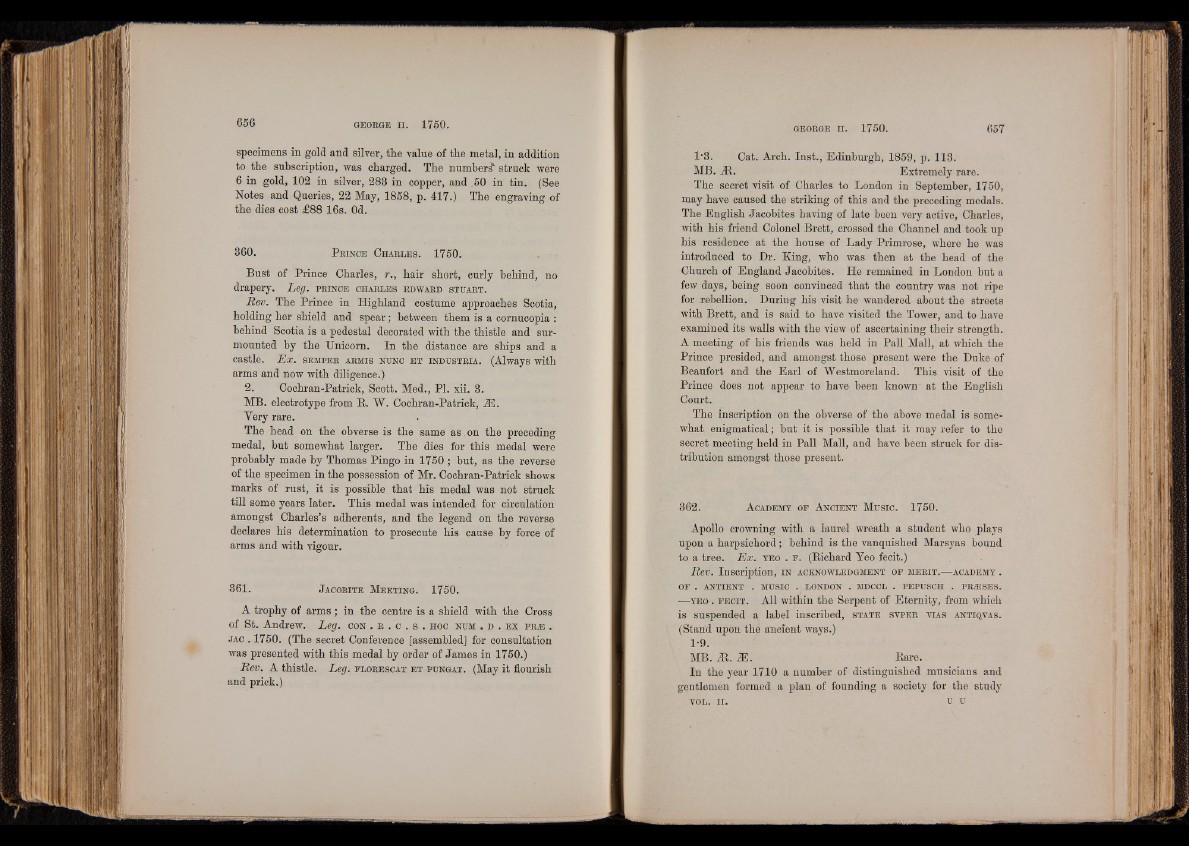
specimens in gold and silver, the value of the metal, in addition
to the subscription, was charged. The numbers1' struck were
6 in gold, 102 in silver, 283 in copper, and .50 in tin. (See
Notes and Queries, 22 May, 1858, p. 417.) The engraving of
the dies cost £88 16s. Od.
360. P b in c e C h a e l e s . 1750.
Bust of Prince Charles, r., hair short, curly behind, no
drapery. Leg. p b in c e c h a e l e s edw a e d s t u a b t .
Rev. The Prince in Highland costume approaches Scotia,
holding her shield and spear; between them is a cornucopia :
behind Scotia is a pedestal decorated with the thistle and surmounted
by the Unicorn. In the distance are ships and a
castle. Ex. s e m p e e a bm is n unc e t in d u s t b ia . (Always with
arms and now with diligence.)
2. Cochran-Patrick, Scott. Med., PI. xii. 3.
MB. electrotype from R. W. Cochran-Patrick, 2E.
Yery rare.
The head on the obverse is the same a s . on the preceding
medal, but somewhat larger. The dies for this medal were
probably made by Thomas Pingo in 1750 ; but, as the reverse
of the specimen in the possession of Mr. Cochran-Patrick shows
marks of rust, it is possible that his medal was not struck
till some years later. This medal was intended for circulation
amongst Charles’s adherents, and the legend on the reverse
declares his determination to prosecute his cause by force of
arms and with vigour.
361. J a c o b it e M e e t in g . 1750.
A trophy of arms; in the centre is a shield with the Cross
of St. Andrew. Leg. con . e . c . s . hoc num . d . e x b e .® .
ja c . 1750. (The secret Conference [assembled] for consultation
was presented with this medal by order of James in 1750.)
Rev. A thistle. Leg. f l o e e s c a t e t ptjngat. (May it flourish
and prick.)
l'S. Cat. Arch. Inst., Edinburgh, 1859, p. 113.
MB. 2R. Extremely rare.
The secret visit of Charles to London in September, 1750,
may have caused the striking of this and the preceding medals.
The English Jacobites having of late been very active, Charles,
with his friend Colonel Brett, crossed the Channel and took up
his residence at the house of Lady Primrose, where he was
introduced to Hr. King, who was then at the head of the
Church of England Jacobites. He remained in London but a
few days, being soon convinced that the country was not ripe
for rebellion. During his visit he wandered about the streets
with Brett, and is said to have visited the Tower, and to have
examined its walls with the view of ascertaining their strength.
A meeting of his friends was held in Pall Mall, at which the
Prince presided, and amongst those present were the Duke of
Beaufort and the Earl of Westmoreland. This visit of the
Prince does not appear to have been known' at the English
Court.
The inscription on the obverse of the above medal is somewhat
enigmatical; but it is possible that it may refer to the
secret meeting held in Pall Mall, and have been struck for distribution
amongst those present.
362. A cademy o f A n c ie n t M u s ic . 1750.
Apollo crowning with a laurel wreath a student who plays
upon a harpsichord; behind is the vanquished Marsyas bound
to a tree. Ex. y eo . f . (Richard Yeo fecit.)
Rev. Inscription, in a ck n ow l ed gm en t o f m e e it .-— academy .
OF . ANTIENT . MUSIC . LONDON . MDCCL . PEPUSCH . PBIESES.
-—y eo . f e c i t . All within the Serpent of Eternity, from which
is suspended a label inscribed, s t a t e s v p e e v ias an t iq v a s .
(Stand upon the ancient ways.)
1-9.
MB. M. M. Rare.
In the year 1710 a number of distinguished musicians and
gentlemen formed a plan of founding a society for the study
v o l . ii. u u